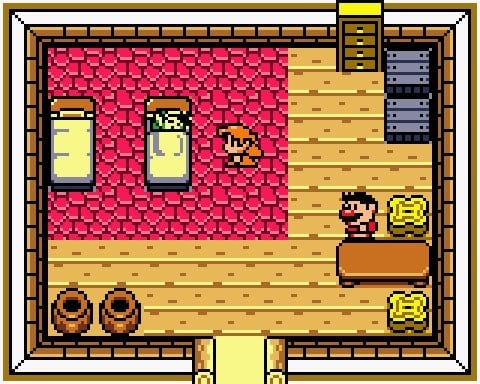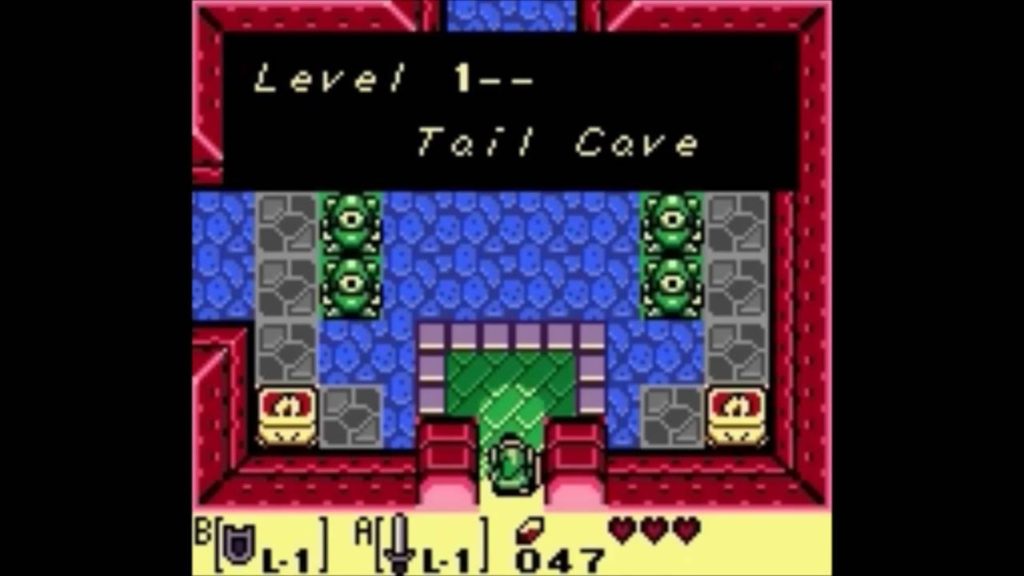Level By Level
‘Link’s Awakening’ Dungeon by Dungeon: Tail Cave
The Nintendo rumor wheel is always turning, churning out seemingly credible rumblings of dream games day in and day out. And since Nintendo has not yet given any firm release dates to any of its titles past this month, these rumors are whirling with tornado-like frenzy. In honor of new year’s dreams, the left-field games Nintendo sometimes throws our way, and whispers of a sequel to this legendary game, I will be analyzing The Legend of Zelda: Link’s Awakening dungeon-by-dungeon. As I have with The Legend of Zelda: Ocarina of Time, each entry in this series will focus on a particular dungeon, delving into the intricacies of various aspects of design. Because it adds color and an additional optional dungeon, I will be looking specifically at the 1998 re-release The Legend of Zelda: Link’s Awakening DX. In this entry, I will be examining Link’s Awakening’s first dungeon, Tail Cave.

Welcome to Koholint Island! At the start of the game, Link awakens inside the home of Tarin and his daughter Marin, who rescued Link after finding him shipwrecked on the beach. After Tarin returns Link’s shield, Link heads back to the beach to fetch his sword, and an owl tells him to head north. In the Mysterious Woods, Link must find a mushroom to hand to a witch who uses it to derive a magic powder. Link then uses this powder on a raccoon who turns out to be Tarin, and he is then granted access to the Tail Key, which he can use to access Tail Cave to the south. While the first portion of these events is a fairly straightforward tutorial, the mix of mazy topography with a short trading sequence might give first-timers a stalled start.
To get this critique out of the way in this first entry: navigation in this game’s overworld is often a trial-and-error slog, sometimes exacerbated by vague or obscure directions (such as by the owl’s note on finding Tail Cave). Part of the reason for this aggravating navigation is that the game’s top-down perspective can make it difficult to decide how to reach a destination. In Ocarina of Time, the player can see the game’s major regions from a distance, making it easier to determine how to get to a general region, and which exact paths to take when they are closer. Here, however, the indeterminate game map can make it tough to pinpoint precise locations, and the numerous narrow winding paths can make smaller-scale pathfinding a crapshoot. This is more tedious here than in A Link to the Past because the environments are less aesthetically distinct and the screen-by-screen loading system doesn’t always feel suited to the overworld’s layout, where topographical barriers often constituent several screens in a row. This is all exacerbated by the game-long trading sequence which, though occasionally charming, demands the player consistently run through the overworld in search of a destination they may only have a vague notion of.

Anyway, the entrance to Tail Cave greets the player with three long-tailed totems that turn out to be the dungeon’s signature Moldorm enemy. Also in keeping with its name, Tail Cave’s layout is of a Moldorm, though it can be difficult to distinguish on the dungeon map, which reads a bit like a small muddied Picross puzzle. While this gimmicky layout does not inherently benefit the dungeon’s design, it does allow for a large central area with three main branching paths, keeping the layout simple, if not quite as clean as Ocarina’s first dungeon, Inside the Deku Tree. The dungeon design’s biggest detractors are that it can be a little windy, lacking in visual markers, and many of its rooms creep across multiple screens. For example, six of the dungeon’s twenty-five screens constitute the central area, which means that nearly one-quarter of the dungeon is a single room divided into six pieces that feel more like sub-rooms than part of an organic whole, since the screen does not follow Link around as in the dungeons of A Link to the Past.

Like most of the dungeons in Link’s Awakening, Tail Cave feels distinctly lacking in theme. Of course, its central theme is in its moniker: “tail.” But compared to the lush themes of 3D Zelda dungeons, the notion of “tail” can only be taken so far. In fact, the dungeon does essentially nothing with this theme outside of being superficially integrated into its name, layout, one enemy type, and boss. It’s odd, for example, that the first room is full of one-eyed statues rather than long-tailed ones. How does such low-hanging fruit go unpicked? Even something as simple as thematically apropos statues could have offered an at least superficial sense of unity. But an enemy that swipes his tail could have utilized Roc’s Feather by making Link jump rope in defense. Or there could have been puzzles involving pulling tail-like levers. The near-total lack of actual tails, though strange to complain about, is baffling. In practice, though, the dungeon’s primary concern is introducing the player to the basics of dungeons. This it does relatively well, outside of its dungeon map, which is easy to bypass. Tail Cave does an especially stand-up job clearly conveying requirements for getting keys by introducing several core methods (defeat all enemies, hit a switch, etc.) within the first few rooms. But even ditching its supposed theme, Tail Cave’s design feels scattershot because it fails to introduce any meaningful motifs. Its puzzles, for example, are isolated one-offs rather than a string of similar puzzles that crescendo in complexity, ultimately giving off little sense of identity.

Tail Cave’s item is Roc’s Feather, an apparent reference to Super Mario Kart’s feather from the year before, both of which allow the player to jump. In Link’s Awakening, Roc’s Feather is primarily used to cross gaps, though it can also be used to collect floating items and can later be combined with the Pegasus Boots cross longer gaps. It is arguably the most storied item in all of Link’s Awakening, and for good reason. Roc’s Feather enables the Hero of Time to tackle one of his most glaring deficiencies (jumping) while also adding light platforming and justifying the Mario-like side-scrolling sections of dungeons which are typically an enjoyable change of pace. The manner in which Roc’s Feather allows the player to traverse the same parts of the dungeon as before but access new parts is a genius, micro-Metroidvanian way of squeezing the most value out of these necessarily tiny spaces. Still, it would have been nice to have a couple more floating items to leap for and enemy types designed around this item.
Tail Cave is home to ten different enemy types and hazardous obstacles, seven of which were previously in A Link to the Past (Blade Trap, Hardhat Beetle, Keese, Mini-Moldrom, Spark, Stalfos, and Zol), which remain essentially unchanged. The new Spiked Beetles can be flipped with a shield and then attacked, while Three-of-a-Kinds can only be defeated by timing your hit so their slot-machine-like bellies read the same suit of cards. As an unusually early cross-reference, Goombas appear during the side-scrolling sequences, which Link can use Roc’s Feather to stomp on just as Mario can do featherlessly. These three new enemies are easily the best of the bunch, with each requiring a more thoughtful and game-specific strategy than enemies of yore. The only major downside is that none of these enemies adequately take advantage of Roc’s Feather outside of Goombas, which pose no real threat and don’t occur during the top-down parts of the dungeon.

One of Link’s Awakening’s greatest contributions to the Zelda series is its mini-bosses, of which Rolling Bones is the very first. Fought shortly after acquiring Roc’s Feather, Rolling Bones is like a pudgy proto-Pikmin that pushes a Rolling Spike Trap Link must jump over to dodge. Although the fight can be easily cheesed by forcing Rolling Bones into a corner, the premise is absolutely superb and a perfect example of how to build a boss around a dungeon’s item (which Link’s Awakening takes more seriously than any previous Zelda). Meanwhile, main boss Moldorm feels nearly copy-and-pasted from A Link to the Past. Giving him a new mechanic that would force Link to jump (such as spinning his tail in a circle) could have made this instantiation more unique and thematically apropos, but as it stands Rolling Bones is a far more memorable, enjoyable, and fitting boss. In fact, if Rolling Bones were a bit tougher, the two bosses would have been better off switched. Furthermore, the placement of Moldorm right after Rolling Bones makes it feel as though the final third of the dungeon was removed, leaving a curious gap in content.

Tail Cave might lack the subtle genius and emotional faculty of Inside the Deku Tree, but it successfully imparts core dungeon knowledge while finding enough room to add some inconsistent flair. And it’s that flair, that unabashed oddness, and unpredictability, that makes Link’s Awakening so fondly remembered by fans of the series. Tail Cave is at its best when it doubles-down on its own uniqueness through its singular Roc’s Feather, wonderfully diverse and comparatively deep new enemies, and incredible mini-boss. But just as often, Tail Cave strives to be a portable A Link to the Past, and that desire often results in a bit too much rehashed design (such as its boss and other enemies) or design that does not befit a small screen (i.e. dividing individual rooms into several segmented pieces). In this regard, Tail Cave is a qualified success, linked a bit too heavily to the past and not yet fully awakened.
For deep dives into other levels from Link’s Awakening, as well as levels from other classic Nintendo games such as Super Mario Odyssey and The Legend of Zelda: Ocarina of Time, click here.

-

 Features4 weeks ago
Features4 weeks agoThis Upcoming Romance Anime Might Just Break the Internet; Trailer Just Dropped!
-

 Features3 weeks ago
Features3 weeks agoDon’t Watch These 5 Fantasy Anime… Unless You Want to Be Obsessed
-

 Features3 weeks ago
Features3 weeks ago“Even if it’s used a little, it’s fine”: Demon Slayer Star Shrugs Off AI Threat
-

 Culture3 weeks ago
Culture3 weeks agoMultiplayer Online Gaming Communities Connect Players Across International Borders
-

 Features1 week ago
Features1 week agoBest Cross-Platform Games for PC, PS5, Xbox, and Switch
-

 Game Reviews3 weeks ago
Game Reviews3 weeks agoHow Overcooked! 2 Made Ruining Friendships Fun
-

 Guides4 weeks ago
Guides4 weeks agoMaking Gold in WoW: Smart, Steady, and Enjoyable
-

 Features2 weeks ago
Features2 weeks ago8 Video Games That Gradually Get Harder
-

 Game Reviews3 weeks ago
Game Reviews3 weeks agoHow Persona 5 Royal Critiques the Cult of Success
-

 Features2 weeks ago
Features2 weeks agoDon’t Miss This: Tokyo Revengers’ ‘Three Titans’ Arc Is What Fans Have Waited For!
-

 Guides2 weeks ago
Guides2 weeks agoHow to buy games on Steam without a credit card
-

 Features7 days ago
Features7 days agoThe End Is Near! Demon Slayer’s Final Arc Trailer Hints at a Battle of Legends




















